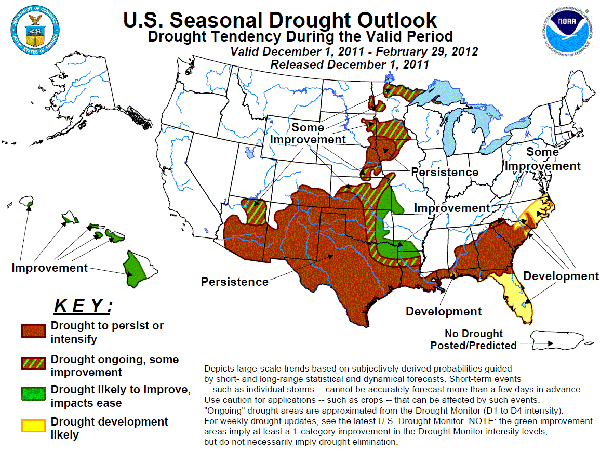03/09/2012 Update to this article: Since we posted this report, repeated rains and mild temperatures have reversed the prospects for the 2012 wildflower season. 2012 is now predicted to be an outstanding wildflower season across the entire state.

There’s bad news for Texas wildflower riders. According to National Weather Service’s Climate Prediction Center the drought is expected to continue or worsen into 2012 for most of the state.
Here’s the text of the report:
Latest Seasonal Assessment – La Niña conditions developed during the northern hemisphere fall for a second year in a row, with below average equatorial Pacific sea surface temperatures expected to persist through the 2011-2012 winter season. Therefore, climate anomalies associated with La Niña winters were closely considered both for the U.S. Drought Outlook and the CPC monthly and seasonal guidance. During the previous two weeks, widespread rainfall further eased lingering drought conditions across the lower Mississippi Valley and southeastern Plains in a continuation of a wet autumn pattern. Short term forecasts indicate new rounds of heavy rainfall in early December, which will likely bring additional improvement from southeastern Kansas through northern Louisiana. An early December winter storm might also bring some early mountain snowfall to the Southwest, though overall below median precipitation is expected during the winter season. Ongoing drought conditions elsewhere across the southern tier of U.S. states are expected to persist or worsen, however, with drought development likely across the Florida Peninsula. Drought development is also possible across eastern North Carolina, where the CPC seasonal outlook indicates enhanced odds of below median precipitation. While La Niña winters favor a wetter pattern across the northern U.S., a combination of recent excessive dryness across portions of the western Corn Belt, a drier winter climatology, and frozen soil and streams reduce the prospects for significant improvement of drought impacts in the upper Midwest and Great Lakes.
Forecaster: A. Allgood
– SOURCE National Weather Service

